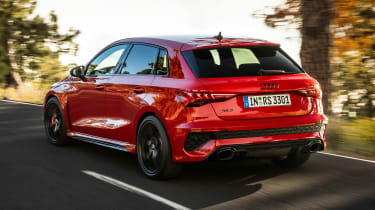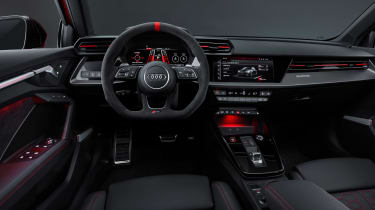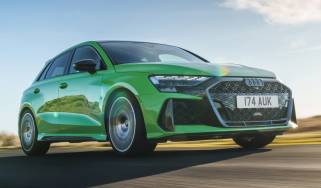New 395bhp Audi RS 3 hot hatchback priced from £50,900
The latest Audi RS 3 giant-slaying hyper hatch can sprint from 0–62mph in 3.8 seconds and has claimed the Nurburgring lap record for compact cars
The new Audi RS 3 is on sale in the UK now priced from £50,900 for the hatchback and £51,900 for the saloon. First deliveries are expected to arrive in November.
Designed to rival the Mercedes-AMG A 45 S, the Audi RS 3 is powered by a turbocharged 2.5-litre five-cylinder petrol engine, which produces 395bhp and 500Nm of torque.
Power goes to all four wheels via a seven-speed dual-clutch automatic gearbox and a clever torque-splitting rear differential – and Audi says the hatchback can get from 0–62mph in just 3.8 seconds before running into its electronic speed limiter at 155mph.
Audi has separated the RS 3 line-up into four trim-levels. The cheapest model comes as standard with 19-inch alloy wheels, LED headlights and cruise control.
Inside, buyers get dual-zone climate control, heated Nappa leather sports seats, a 12.3-inch digital instrument cluster and a 10.1-inch touchscreen infotainment system.
Above the base-model, there’s the RS 3 Carbon Black. It’s priced from £55,550 and adds matte black 19-inch alloy wheels, tinted Matrix LED headlamps, a gloss black front splitter and a carbon fibre finish for the mirror caps, rear spoiler, side skirts and engine cover.
Audi has also created a limited-run RS 3 Launch Edition, of which just 96 examples will be sold in the UK. Priced from £56,900, each comes with adaptive suspension, a sports exhaust system, a panoramic glass sunroof and red brake calipers.
The cabin gets electric front seats, a premium Bang & Olufsen stereo system, a head-up display, a hidden wireless smartphone charger and gloss black trim for the dashboard. Audi has also raised the car’s top speed limiter to 174mph.
The range-topping Audi RS 3 Vorsprung is priced from £58,650. Upgrades include black 19-inch alloy wheels, an electrically operated tailgate and a 360-degree parking camera. All of these trims are available on the RS 3 Saloon, which is priced at £1,000 more spec-for-spec.
Audi also offers an optional RS Dynamic pack, which costs an extra £5,500 on the base-model and £5,000 on Carbon Black and Vorsprung variants. It groups together a host of optional extras, including adaptive dampers, ceramic brakes and a sports exhaust system. The package also increases the RS 3’s top speed to 180mph.
New Audi RS 3: Nurburgring lap-record holder
The Audi RS 3 has set the Nurburgring lap record for compact cars, with a time of 7:40.7 minutes – which is 4.6 seconds quicker than the previous record held by the Renault Megane RS Trophy-R.
The record-breaking lap was set by Audi development driver Frank Stippler, with the RS 3 running on optional road-legal Pirelli Trofeo R tyres (which aren’t offered in the UK). Optional carbon ceramic brakes were also fitted to the car, saving 10kg over the standard steel items.
Audi’s new “torque splitter” differential played a key role in the lap time. The technology makes its debut on the RS 3 and uses a multi-plate clutch on each rear driveshaft to send up to 100 percent of the engine’s torque to each rear wheel for better cornering.
Stippler says the torque splitter has a profound benefit on track. “The new RS 3 is much more agile when driving from the middle of the curve to its end and when accelerating out of the curve,” he said. “For me, the torque splitter is a quantum leap in terms of agile driving.”
Audi’s Nurburgring effort not only overthrows the Megane RS Trophy-R, but numerous fully-fledged sports cars, too. The Aston Martin Vantage, Porsche Taycan and Lotus Exige Cup 380 all trail the RS 3’s lap time.
New Audi RS 3: chassis and platform
The RS 3 uses an upgraded version of the MQB Evo underpinnings found under the Audi S3, fitted with the brand’s trademark quattro all-wheel drive system and all-new RS Torque Splitter rear differential.
The system has a few different driving modes. Comfort/Efficiency prioritises power to the front wheels, while Auto mode sees the torque split balanced intelligently according to the conditions and driving style.
Dynamic mode sends extra torque to the rear wheels to improve agility. RS Performance mode was created specifically for the track, sharpening the engine and transmission calibrations, while using the rear differential to reduce understeer and oversteer.
However, if you want to be a hooligan, the chassis has another setting called RS Torque Rear, which directs most of the engine’s power to the outside rear wheels to make it easier to control drifts. Three ESC modes (on, ESC Sport and off) also determine how much drift angle the car will allow.
Audi has also engineered plenty of chassis tweaks over the S3 hot hatch to support the RS 3’s increased performance. The car’s ride height is 10mm lower than the S3’s and, at the front, the RS 3 uses MacPherson strut suspension with unique pivot bearings, strengthened lower wishbones and a more rigid subframe.
An RS-specific variable steering ratio also varies the speed of the steering depending on the steering angle, which helps maintain stability around the straight-ahead position, while boosting turn-in response in the corners.
The rear of the car has been thoroughly overhauled to accommodate the new rear differential, with a bespoke subframe, a new anti-roll bar and a fresh multi-link axle design with separate springs and shock absorbers.
Buyers can also upgrade the car’s setup to make it perform better on the track. Audi’s optional RS sport suspension adds adaptive dampers and an extra degree of negative camber, which the brand says results in “more precise steering response.”
Click here for our list of the best hot hatchbacks on sale right now...
Find a car with the experts












